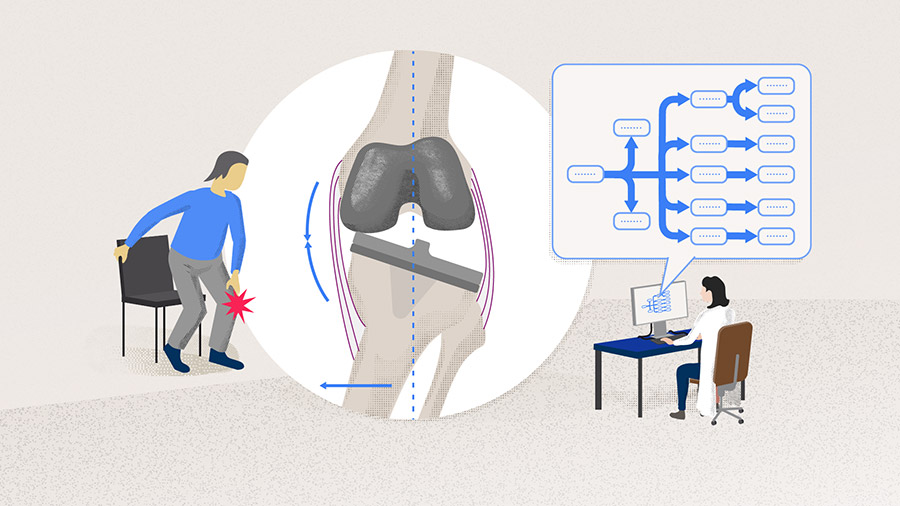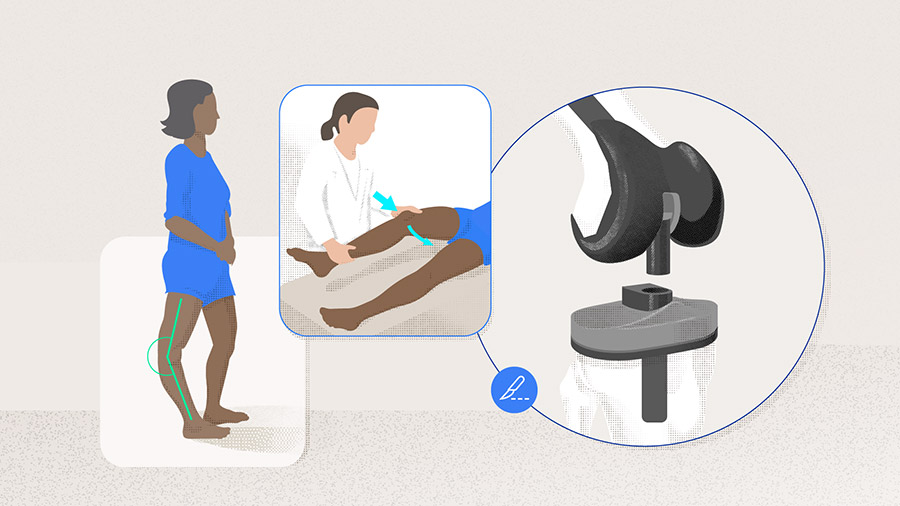Etiology and classification of the unstable total knee arthroplasty
Preview
Total knee arthroplasty (TKA) is a common and successful surgery for the treatment of osteoarthritis of the knee with good outcomes in pain, function, and quality of life. However, in some patients instability occurs after the primary arthroplasty leading to the need for a revision TKA. The causes of instability are manifold and the types of instability occurring are unique, each requiring a specific treatment strategy. In this article, Dario E Garin, Hospital Ángeles Tijuana, Tijuana, Mexico, takes a closer look at instability after TKA, starting with an examination of the etiology and classification of the unstable TKA.

Dario E Garin
Hospital Ángeles
Tijuana, Mexico
The number of primary and revision total knee arthroplasties is increasing on a global scale
Total knee arthroplasty is a well-established procedure with high success rates in the treatment of patients with osteoarthritis of the knee [1]; patients undergoing TKA have reported improvements in pain and function as well as in quality of life [1]. In 2007, Kurtz et al [2] predicted that the demand for TKA would increase by 291% from 2005 to 2020 in the US alone. Over the last years, data from the US has shown a steady increase in the prevalence of primary TKA and revision TKA [3, 4], and this trend is supported by the yearly data from different national joint replacement registries [4-6], with an 8–9% increase in number of primary TKAs [5, 6] and ~ 7% increase in revision TKAs from 2020 to 2021 [5, 6].
This global trend towards an increased volume of primary and revision TKAs is set to continue [1, 7] and adding to this burden is the expanded demographic of the patients to include those who are young and active [1]. As Dario E Garin notes, the number of TKAs has increased worldwide due to early osteoarthritis secondary to obesity, sports-related injuries, and patients with a more active lifestyle.
Instability is an important major indication for revision
In 2015, McNabb et al [3] summarized the causes of primary TKA failure as infection, aseptic loosening, instability, stiffness, and polyethylene wear. As depicted in Figure 1, which shows the reasons for primary TKA revisions across different registries, there are manifold reasons for revision. Although there are differences observed in the diagnostic codes used across countries, what is consistent is that infection is the top reason for revision [4–6, 8]. In the US, periprosthetic joint infection (PJI) and aseptic loosening are the main reasons for nearly half of all revision TKAs [9] and in Germany, for example, PJI is a primary reason driving the projected increase in number of revision TKAs over the next decades [1]. In contrast, aseptic loosening or lysis is the primary reason for revision in the UK [10].
Aside from PJI or aseptic loosening, instability is one of the main causes of revision TKA (Figure 1) [5, 6, 8–10]. Data show that the number of revision TKAs associated with instability appears to be increasing [9, 11]. In an analysis by Upfill-Brown et al [9], a significant increase (P < .001) in the proportion of procedures associated with instability was observed from 2012 to 2019 (9–12.8%). Furthermore, in Australia there was a consistent increase in revision TKAs due to instability seen from 6% in 2003 to 18% in 2019 [11]. The reason for this increase is poorly understood, but it has been suggested to be related to an increased awareness of different forms of instability, such as midflexion instability, by Lewis et al [11].
Read the full article with your AO login
- Increasing number of primary and revision total knee arthroplasties on a global scale
- Instability is an important major indication for revision
- The etiology and symptoms of instability after total knee arthroplasty
- Risk factors for instability in total knee arthroplasty
- Classification of the unstable total knee arthroplasty
- Extension instability
- Flexion instability
- Midflexion instability
- Genu recurvatum
- Global multiplanar instability
- Conclusion
Additional AO resources
Access videos, tools, and other assets.
- Videos
- Upcoming events: AO Recon Course finder
- Surgery Reference: Periprosthetic Fractures—Unified Classification System for Periprosthetic Fractures (UCPF)
Contributing experts

Dario E Garin
Hospital Ángeles
Tijuana, Mexico

Beatriz Montoya-Ortiz
Clínica El Rosario
Medellín, Colombia

Sam Oussedik
AO Recon Joint Preservation Knee Curriculum Taskforce
University College Hospital London
London, UK
This issue was written by Lyndsey Kostadinov, AO Innovation Translation Center, Clinical Science, Switzerland.
References
- Klug A, Gramlich Y, Rudert M, et al. The projected volume of primary and revision total knee arthroplasty will place an immense burden on future health care systems over the next 30 years. Knee Surg Sports Traumatol Arthrosc. 2021 Oct;29(10):3287–3298.
- Kurtz SM, Ong KL, Lau E, et al. Impact of the economic downturn on total joint replacement demand in the United States: updated projections to 2021. J Bone Joint Surg Am. 2014 Apr 16;96(8):624–630.
- McNabb DC, Kim RH, Springer BD. Instability after Total Knee Arthroplasty. Stuttgart(?): Thieme Medical Publishers; 2015: 097–104.
- American Joint Replacement Registry (AJRR): 2022 Annual Report. Rosemont, IL: American Academy of Orthopaedic Surgeons (AAOS), 2022.
- W-Dahl A, Kärrholm J, Rogmark C, et al. The Swedish Arthroplasty Register, Annual Report. Gothenburg; 2022. Available at: Annual report 2022 (windows.net). Accessed August 2023.
- Australian Orthopaedic Association National Joint Replacement Registry (AOANJRR). Hip, Knee & Shoulder Arthroplasty: 2022 Annual Report, Adelaide; AOA, 2022: 1–487.
- Kurtz S, Ong K, Lau E, et al. Projections of primary and revision hip and knee arthroplasty in the United States from 2005 to 2030. J Bone Joint Surg Am. 2007 Apr;89(4):780–785.
- Canadian Institute for Health Information. CJRR Annual Report, 2020–2021 — Updated September 2022. Ottawa, ON: CIHI; 2022.
- Upfill-Brown A, Hsiue PP, Sekimura T, et al. Epidemiology of Revision Total Knee Arthroplasty in the United States, 2012 to 2019. Arthroplast Today. 2022 Jun;15:188–195.e186.
- Ben-Shlomo Y, Blom A, Boulton C, et al. The National Joint Registry 19th Annual Report 2022 [Internet]. London: National Joint Registry; 2022 Oct. Available from: https://www.ncbi.nlm.nih.gov/books/NBK587525/. Accessed August 2023.
- Lewis PL, Campbell DG, Lorimer MF, et al. Primary Total Knee Arthroplasty Revised for Instability: A Detailed Registry Analysis. J Arthroplasty. 2022 Feb;37(2):286–297.
- Al-Jabri T, Brivio A, Maffulli N, et al. Management of instability after primary total knee arthroplasty: an evidence-based review. J Orthop Surg Res. 2021 Dec 20;16(1):729.
- Chang MJ, Lim H, Lee NR, et al. Diagnosis, causes and treatments of instability following total knee arthroplasty. Knee Surg Relat Res. 2014 Jun;26(2):61–67.
- Song SJ, Detch RC, Maloney WJ, et al. Causes of instability after total knee arthroplasty. J Arthroplasty. 2014 Feb;29(2):360–364.
- Rodriguez-Merchan EC. Instability following total knee arthroplasty. Hss j. 2011 Oct;7(3):273–278.
- Gonzalez MH, Mekhail AO. The failed total knee arthroplasty: evaluation and etiology. J Am Acad Orthop Surg. 2004 Nov-Dec;12(6):436–446. Cited by: Chang MJ, Lim H, Lee NR, et al. Diagnosis, causes and treatments of instability following total knee arthroplasty. Knee Surg Relat Res. 2014 Jun;2026(2012):2061–2067.
- Winiarsky R, Barth P, Lotke P. Total knee arthroplasty in morbidly obese patients. J Bone Joint Surg Am. 1998 Dec;80(12):1770-1774. Cited by: Chang MJ, Lim H, Lee NR, et al. Diagnosis, causes and treatments of instability following total knee arthroplasty. Knee Surg Relat Res. 2014 Jun;1726(1772):1761–1767.
- Vajapey SP, Pettit RJ, Li M, et al. Risk Factors for Mid-Flexion Instability After Total Knee Arthroplasty: A Systematic Review. J Arthroplasty. 2020 Oct;35(10):3046–3054.
- Morgan-Jones R, Graichen H. Balance and constraint in revision TKR: A classification for instability management. J Orthop. 2021 Mar–Apr;24:19–25.
- Petrie JR, Haidukewych GJ. Instability in total knee arthroplasty : assessment and solutions. Bone Joint J. 2016 Jan;98-b(1 Suppl A):116–119.
- Ramappa M. Midflexion instability in primary total knee replacement: a review. Sicot j. 2015 Aug 5;1:24.
- Stambough JB, Edwards PK, Mannen EM, et al. Flexion Instability After Total Knee Arthroplasty. J Am Acad Orthop Surg. 2019 Sep 1;27(17):642–651.




